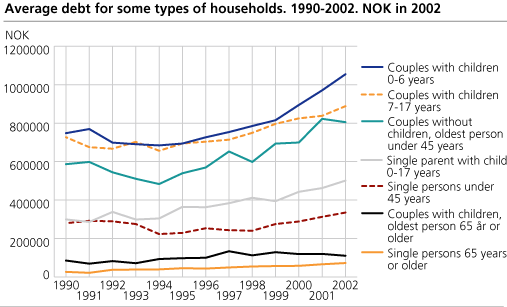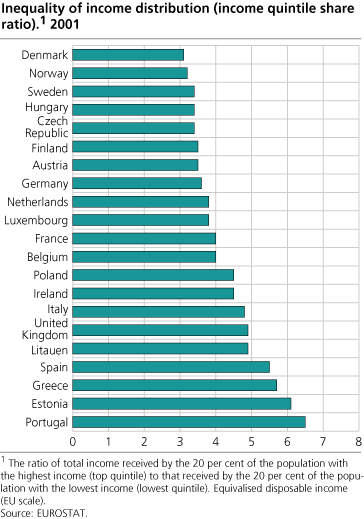Content
Published:
This is an archived release.
More debt for households with small children
Average debt for Norwegian households in 2002 was NOK 495 500. From 2001 to 2002 average debt per household increased by 7 per cent. Couples with children in the age group 0-6 years had the strongest increase in debt. This household type is also over-represented among households with a large debt compared to their household income.
Average debt for couples with children, where the youngest child is in the age group 0-6 years, is more than NOK 1 million. Since 1999, this household type has experienced an increase in debt by 29 per cent. In addition, more households with small children experienced to have a large debt compared to their income. Whereas 5 per cent of this household type had a debt that was three times larger than their total household income in 1999, this percentage increased to 11 per cent in 2002. Households with small children have not been this much indebted since the early 1990s.
Most household groups have become more indebted in recent years. Single parents, for example, increased their average debt by 27 1 per cent since 1999. Among the different types of households, only couples without children where the main income earner is 65 years or older, have had a decline in debt since 1999.
There has been an increase in the proportion of households with a large debt compared to their income. Since the mid 1990s it has become more common to borrow more than three times the size of total household income. At the same time we see that a decreasing proportion of Norwegian households is totally without debt. 28 per cent of all households had no debt at all in 1990. This percentage dropped to 20 in 2002.
Largest income rise for older households
In 2002 average after-tax income for Norwegian households was NOK 333 500. From 1990 to 2002 the median after-tax income for all households rose with roughly 22 per cent, in real prices.
All household types have experienced an income rise in recent years. There is nevertheless a tendency that the older households have had a stronger rise in income compared to younger households. We find this trend among singles, couples with children, as well as among couples without children. In particular couples without children, where the main income earner is 65 years and older, have had a solid increase in household income.
Greater inequality in the distribution of income
In order to study changes in the income distribution it may be useful to split the population into 10 equally sized groups (deciles), after ranking each individual by the size of their household after-tax income per consumption unit. Decile 1 will thus be the 10 per cent of the population with the lowest income, while decile 10 are the 10 per cent with the highest income.
Income statistics show that the distribution became more unequal in 2002. While the 10 per cent of the population with highest income received 20.3 per cent of total income in 2001, the corresponding figure for 2002 rose to 23.6 per cent. All other decile groups at the same time experienced a reduction in their share of total income. The 10 per cent of the population with the lowest income, for example, faced a reduction in their share of total income from 3.9 per cent in 2001 to 3.6 per cent in 2002. The ratio between average income of the 10 t h decile to that of the 1 s t decile increased from 5.2 in 2001 to 6.6 in 2002.
Compared to 2000 the change in inequality is more modest. The increase in income inequality from 2001 to 2002 can to a large extent be explained by a substantial decrease in property income in 2001, due to the introduction of new taxes on dividends this year. The year after this tax was abolished, and the dividends went up again. For more information see Tax Return Statistics, 2002 . Property income, such as dividends and capital gains, are primarily received by households at the upper end of the income distribution.
Less income inequality in the Nordic countries compared to most other European countries
According to the statistical office of the European Union (Eurostat), there are substantial differences within Europe in respect to income distribution. If one considers the ratio between the 20 per cent of the population with highest household income and the 20 per cent with lowest household income as a measure of income inequality, Denmark was the country with the smallest income inequality in 2001, while Portugal was the country with the largest income dispersion. Along with the other Nordic countries Norway was situated among the countries with the smallest income dispersion that particular year. One should, however, note that the income data used in such international comparisons are somewhat older than the national figures presented elsewhere in this article. In addition the income concept is slightly different.
Statistical basis
The basis for the income and property statistics for households is a sample of roughly 22 000 private households. The household composition has been established from household interviewing and register information, while all income data have been collected from different administrative or statistical registers.
| 1 | Corrected 14 May 2004. |
Tables:
- Table 1 Income account for households, by type of household. Average per household. 2002. NOK
- Table 2 Number of persons, gross income, after tax income, assessed property and liabilities for households, by type of household. Average per household. 2002
- Table 3 After tax income for households, by type of household. 1990-2002. At constant prices. 1990=100
- Table 4 Gross financial capital for household, by deciles. 1986-2002
- Table 5 Property account for households. Average per household. 1986-2002. NOK
- Table 6 Property account for households, by type of household. Average per household. 2002. NOK
- Table 7 Property account for households, by age of the main income earner. Average per household. 2002. NOK
- Table 8 Liabilities for households, by type of household. 1990-2002. At constant prices. 1990=100
- Table 9 Number of household, by size of debt compared to total income of the household. 1990-2002
- Table 10 Percentage of household with debt more than three times total household income by different types of household. 1990-2002
- Table 11 Distribution of household equivalent income after taxes,, between persons. (E=0.5). Decile shares and cumulative decile shares. 1990-2002. Per cent
- Table 12 Composition of total household income within decile groups for household equivalent income after taxes, between persons. (E=0.5). Share of total income. 1994, 1998 and 2002. Per cent (New 24 January 2005)
Contact
-
Jon Epland
E-mail: jon.epland@ssb.no
tel.: (+47) 92 61 69 08
-
Elisabeth Løyland Omholt
E-mail: elisabeth.omholt@ssb.no
tel.: (+47) 93 05 55 28
-
Christian Brovold
E-mail: christian.brovold@ssb.no
tel.: (+47) 91 75 31 32
-
Lene Sandvik
E-mail: lene.sandvik@ssb.no
tel.: (+47) 90 13 16 16


